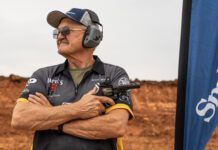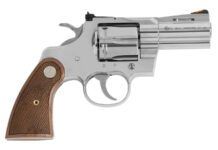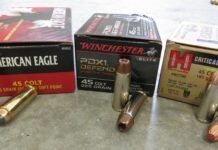We have tested a variety of 22 LR Single Action Army (SAA) revolvers in the past, and those six-shooter revolvers have been the traditional models with 4.75- or 6.5-inch barrels. In this match-up, we wanted to look at shorter-barrel SAA revolvers in 22 LR. So we gathered two Heritage Manufacturing Barkeep models and two Ruger Shopkeeper revolvers. These pistol designs share a similar idea: Abbreviated barrels.
Ever since SAA revolvers were invented, gunsmiths have lopped off a good portion of the barrel to make the pistol easier to carry as a back-up gun. In fact, Colt made centerfire Sheriff models with short barrels and without the ejector rod, and a centerfire 4-inch-barrel Storekeeper’s model with an ejector rod. In the recent past, a variety of SAA manufacturers and importers have introduced short-barrel SAA revolvers.
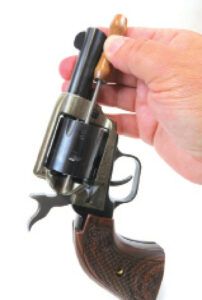
The assembled SAA rimfire revolvers are at polar opposites are far as price is concerned. The Heritage Mfg. Barkeep models are under $200, and the Ruger Shopkeeper models are about $500 to $575. That’s a difference of $300 to $375 if we do the math correctly. We know what you are thinking: Are the Ruger models worth the extra coin?
Where the four revolvers are similar is in chambering, size, weight, barrel lengths, and sights. The Heritage Barkeeps and Ruger Shopkeepers are scaled down so they fit adults as well as small-stature shooters. All of these rimfire revolvers had similar barrel lengths between 2.6 and 3.5 inches and traditional SAA sights, consisting of a front blade and a rear groove notch. Grip style is where the Barkeep and Shopkeeper revolvers differ. The Barkeep models have a traditional SAA grip, while the Shopkeeper models have a smaller bird’s head-style grips. We have gripes about the grips, as you’ll read below. All four are smart-looking revolvers with different finishes that vary in execution.
We think three of these compact SAA revolvers would make fun plinkers. The Rugers are small enough to drop in your back pants pocket or coat pocket when taking a stroll or walking the woods. Tin cans and paper targets don’t care what we use to shoot at them, but as shooters, we care, a lot.
How We Tested
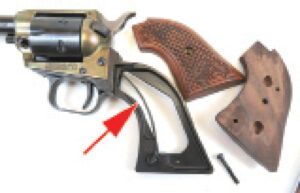
Burning through a bunch of 22 LR ammo, we found all four pistols performed well, though we did find the Rugers more user friendly due to their ejector rods. Sticky empties did not fall free from any of the guns, but a rod with a wood handle, which comes with each Barkeep, helped eject stubborn cases. We tested three flavors of ammo: Remington Thunderbolt with a 40-grain lead round-nose bullets, Winchester Xpert High Velocity rounds with 36-grain hollow points and some zing, and a 38-grain LRN from CCI Blazer. These rounds have a range of velocities and bullet weights and styles, from target rounds to hunting rounds. We had issues loading the Winchester ammo in the Rugers, but not in the Heritage guns. Using our range bag as a rest and firing five-shot groups at cardboard targets, we tested for accuracy at 15 yards. Both Rugers and one of the Heritages shot to point of aim, which is a requirement for a fixed-sight revolver. One of the Barkeeps shot to the left, which doomed it in our eyes. Still, we thought there were some “keepers” in this group.
Gun Tests Grade: C
$189
This model Barkeep is similar to other model Barkeep with two differences. This model has a 3.6-inch barrel and faux gray pearl grips. Actually, there is another big difference between these revolvers. The 3.6-inch barrel version did not shoot to point of aim. We needed to use Kentucky windage and evaluation to dial in on the bullseye.
| Action Type | Revolver, single action |
| Overall Length | 8.8 in. |
| Overall Height | 5.0 in. |
| Barrel Length | 3.6 in. |
| Sight Radius | 4.7 in. |
| Maximum Width | 1.4 in. |
| Weight Unloaded | 27.0 oz. |
| Weight Loaded | 27.7 oz. |
| Cylinder Gap | 0.001 in. |
| Capacity | 6 |
| Frame Finish | Black oxide |
| Barrel/Cylinder Finish | Black oxide |
| Frame Front Strap Height | 2.2 in. |
| Frame Back Strap Height | 3.0 in. |
| Grip | Smooth faux gray pearl |
| Grip Thickness (max) | 1.4 in. |
| Grip Circumference (max) | 5.7 in. |
| Front Sight | Fixed blade |
| Rear Sight | Fixed notch |
| Trigger Pull Weight (SA) | 3.0 lbs. |
| Trigger Span (SA) | 3.0 in. |
| Safety | Manual hammer block |
| Warranty | 1-year limited |
| Telephone | (305) 685-5966 |
| Website | HeritageMfg.com |
| Made In | USA |
Again, the finish was thin on the Barkeep, but the grips were slightly better. No wiggle, but some overlap of the grip frame.
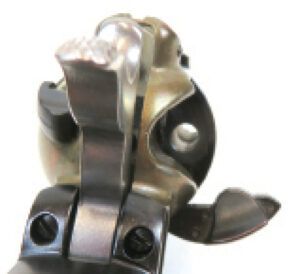
We had no loading issues with either of the Barkeeps. Ejecting empty brass required use of the wood-handle ejector rod. Lose the rod and you will need to use the cylinder pin to punch out empties. Since the Barkeeps are larger than the Bearcats, they are easy to load, especially if you have fat fingers. The loading gate is slightly larger, providing more access to the cylinder.
Going hot, we noticed the 3.6-inch barrel provided the highest muzzle velocity and muzzle energy of all the revolvers tested. That would be great, but the 3.6-inch model did not shoot to point of aim. Aiming dead center at the Thompson Trouble Shooter target, hits printed well off the bullseye. We aimed at a corner of the same target and printed the group in the center of the target.
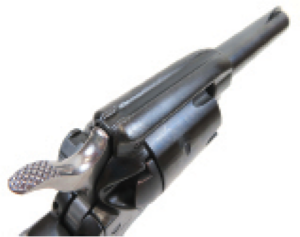
Accuracy was fairly good. Our best five-shot group was with CCI Blazer 38-grain LRNs, which measured 1.10 inches at 15 yards. Remington Thunderbolt with a 40-grain LRN came in a close second, with a best group that measured 1.24 inches. The Winchester 36-grain HP wasn’t too shabby, with a best group of 1.56 inches. On average, expect the 3.6-inch Barkeep to shoot 1.13- to 1.65-inch groups if you do your part. The trigger pull weight was 3 pounds and crisp, with a slight hint of creep. We liked the trigger.
We did find the cylinder gap was very tight on this Barkeep, 0.001 inch, which is much tighter than typical specs. This gave us more velocity, but you might find this revolver would need more diligent cleaning, especially with lead 22 LR bullets. Lead, dry lube, and burn residue could build up and bind the cylinder. The 2.6-inch Barkeep had a 0.007-inch cylinder gap.
Our Team Said: In our opinion, even at the low cost, we’d pass on this particular 3.6-inch Barkeep. Could we have gotten a bad apple? That is possible because we have had good performance from other Heritage revolvers, and the 2.6-inch barrel model was nearly as accurate. More important, the 2.6-inch model shot to point of aim. We still like this plinker but prefer the 2.6-inch model.
22 LR Range Data
| Remington Thunderbolt 40-grain Lead Round Nose | Heritage Barkeep 2.6 in. | Heritage Barkeep 3.6 in. | Ruger Shopkeeper 3 in. | Ruger Shopkeeper 3.5 in. |
| Average Velocity | 860 fps | 1001 fps | 848 fps | 981 fps |
| Muzzle Energy | 66 ft.-lbs. | 89 ft.-lbs. | 72 ft.-lbs. | 85 ft.-lbs. |
| Smallest Group | 0.88 in. | 1.24 in. | 0.51 in. | 0.53 in. |
| Average Group | 1.20 in. | 1.29 in. | 0.58 in. | 0.66 in. |
| CCI Blazer 38-grain Lead Round Nose | Heritage Barkeep 2.6 in. | Heritage Barkeep 3.6 in. | Ruger Shopkeeper 3 in. | Ruger Shopkeeper 3.5 in. |
| Average Velocity | 917 fps | 1007 fps | 939 fps | 892 fps |
| Muzzle Energy | 71 ft.-lbs. | 89 ft.-lbs. | 74 ft.-lbs. | 67 ft.-lbs. |
| Smallest Group | 1.14 in. | 1.10 in. | 0.97 in. | 0.73 in. |
| Average Group | 1.89 in. | 1.13 in. | 1.10 in. | 0.93 in. |
| Winchester Xpert HV 36-grain Hollow Point | Heritage Barkeep 2.6 in. | Heritage Barkeep 3.6 in. | Ruger Shopkeeper 3 in. | Ruger Shopkeeper 3.5 in. |
| Average Velocity | 939 fps | 1048 fps | 947 fps | 952 fps |
| Muzzle Energy | 70 ft.-lbs. | 88 ft.-lbs. | 72 ft.-lbs. | 72 ft.-lbs. |
| Smallest Group | 2.88 in. | 1.56 in. | 1.22 in. | 1.22 in. |
| Average Group | 3.31 in. | 1.65 in. | 1.38 in. | 1.23 in. |
Value Guide: Single-Action Revolver Rankings
| Gun Name | Issue | Grade | Comments |
|---|---|---|---|
| Traditions 1873 Frontier SAT73-002 45 Colt, $614 | Apr. 2022 | A | Best Buy. The revolver is a good buy and will serve well in any role a single-action revolver is suited for. |
| Colt Single Action Army Wiley Clapp P1842WC 45 ACP, $1900 | Apr. 2022 | B | It is expensive, but it is also very good. The very tight base pin was an aggravation in disassembly. |
| Colt Single Action Army P1840 45 Colt, $2400 | Apr. 2022 | B- | The Colt is well made and reliable. The rough trigger action soured our shooting experience with it. |
| Ruger Bisley Hunter 0862 44 Magnum, $1149 | Jan. 2022 | A | The recoil impulse on the Bisley was more comfortable than the standard Super Blackhawk. |
| Ruger Super Blackhawk 44 Magnum, ~$660 | Jan. 2022 | A- | The Pachmayr grips helped hold onto the pistol in movement, almost a bit too well. |
| Heritage Rough Rider Combo 22 LR/22 WMR, $250 | 2021-05-01 00:00:00 | A | Best Buy. Came with a spare 22 Magnum cylinder. The fit and finish are good, had a nice set of cocobolo grips. |
| Ruger Wrangler No. 2004 22 LR, $250 | 2021-05-01 00:00:00 | A- | Reliable, the action is smooth and positive in operation. Accuracy is the best of the test. |
| Traditions 1873 Rancher PVC SAT73-22250 22 LR, $229 | 2021-05-01 00:00:00 | A- | Modified to a transfer-bar system. Also features a hammer-spring tensioner. |
| Chiappa 1873-22 No. 340.250 22 LR, $185 | 2021-05-01 00:00:00 | C | Accuracy isn’t terrible, but it is disappointing. The action was its greatest demerit. |
| Ruger Wrangler Model 2003 22 LR, $210 | 2020-06-01 00:00:00 | A | Shot to point of aim, was accurate, fun to shoot, and costs a fraction of what a Single-Six does. |
| Uberti Cattleman 22 Model 356186 22 LR, $453 | 2020-06-01 00:00:00 | A | A traditionally styled revolver that is well made and accurate. Extra capacity is a plus. |
| Cimarron Plinkerton ASPLINK1 22 LR, $172 | 2020-06-01 00:00:00 | B | Rough fit and finish. It did not shoot to point of aim, but it was accurate. |
| Traditions 1873 Liberty Model SAT73-119LIB 357 Mag., $550 | Mar. 2019 | A | Best Buy. A combination of accuracy and good handling make it the best buy of the test. |
| Traditions 1873 Sheriff’s Model SAT73-005 357 Mag., $410 | Mar. 2019 | B | The shorter barrel limited its performance in all regards, including accuracy, energy, and a full powder burn. |
| Traditions Frontier 1873 PVC SAT73-126 357 Mag., $550 | Mar. 2019 | B | The Frontier revolver must have had a burr in the action of some sort that caused a function problem. |
| BFR Short Cylinder BFR44MAG7 44 Magnum, $1184 | Aug. 2018 | A | Well made, heavy revolver that was accurate, has manageable recoil, and can accept a scope. |
| Cimarron Bad Boy CA360-BAD BOY 44 Magnum, $687 | Aug. 2018 | A | Offers a classic single action with a modern twist by using a Colt 1860 Army-style grip and octagonal barrel. |
| EAA Bounty Hunter 770080 44 Magnum, $520 | Aug. 2018 | B+ | Good accuracy and easy recoil management. The trigger was too heavy, and it did not shoot to point of aim |
| Colt Single Action Army 2nd Generation 45 Colt, $1240 | 2018-07-01 00:00:00 | A | Our Pick. The Colt was well finished, felt good in the hand, and was quite accurate. |
| Uberti 1873 Cattleman Old West No. 355131 45 Colt, $400 | 2018-07-01 00:00:00 | B+ | Best Buy. Though it lagged a step in accuracy, the Uberti exhibited the best trigger of the test. |
| Ruger Vaquero Bisley 5129 45 Colt, $550 | 2018-07-01 00:00:00 | B | The grip frame and trigger helped in deliberate fire. The Ruger was the most accurate revolver tested. |


























